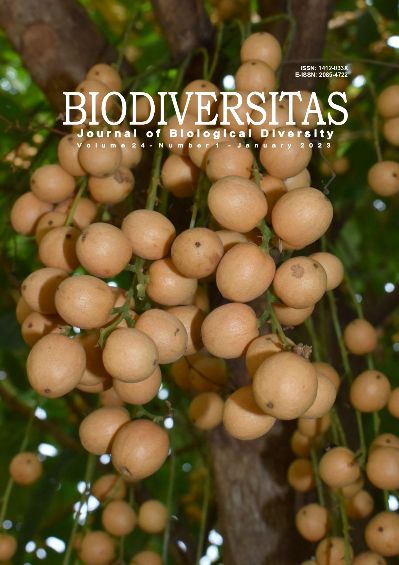Enzyme-producing symbiotic bacteria in gastropods and bivalves molluscs: Candidates for bioindustry materials
##plugins.themes.bootstrap3.article.main##
Abstract
Abstract. Setyati WA, Pringgenies D, Soenardjo N, Pramesti R. 2023. Enzyme-producing symbiotic bacteria in gastropods and bivalves molluscs: candidates for bioindustry materials. Biodiversitas 24: 20-25. Biotechnology plays a vital role in modern civilization because almost all aspects of human life have benefited from the development of biotechnological applications, especially in the bioindustry. Therefore, the present study aims to obtain bacterial isolates from molluscs and identify those with the potential to produce protease, amylase, and cellulase enzymes using bimolecular methods and bacterial biochemical analysis. The samples were collected in April 2022 from the coastal waters of Krakal, Special Region of Yogyakarta, Indonesia. The symbiotic bacteria were isolated, and screened for different enzymatic activity. The molecular method (16S rRNA gene sequence) was used to identify acterial isolates with the highest potential for enzymatic activity. Biochemical analysis of isolates that are potential candidates for industrial materials was carried out using the thin-Layer Chromatography (TLC) method to detect the compounds produced by bacteria. The results showed that the bacterial isolates GS 1-4, GS 2-1, and GS 2-12 had similarity with Alcaligenes faecalis (99.83%), Alcaligenes faecalis (99.74%) and Alcaligenes aquatilis (98.51%) respectively. The three isolates showed the potent enzymatic activity and contained alcohol, amines, aldehyde, ketone and conjugated aromatics, as well as amino acids for potential candidates of bioindustry materials.
##plugins.themes.bootstrap3.article.details##
Most read articles by the same author(s)
- MADA TRIANDALA SIBERO, EVAN HANSEL FREDERICK, AGUS SABDONO, DIAH PERMATA WIJAYANTI, DELIANIS PRINGGENIES, OCKY KARNA RADJASA, DEWI SESWITA ZILDA, RETNO MURWANI, First report of seaweed-associated yeast from Indonesia: Species composition and screening of their polysaccharides-degrading enzymes , Biodiversitas Journal of Biological Diversity: Vol. 23 No. 3 (2022)
- FATMAWATI FATMAWATI, MADA TRIANDALA SIBERO, AGUS TRIANTO, DIAH PERMATA WIJAYANTI, AGUS SABDONO, DELIANIS PRINGGENIES, OCKY KARNA RADJASA, The influence of fermentation using marine yeast Hortaea werneckii SUCCY001 on antibacterial and antioxidant activity of Gracilaria verrucosa , Biodiversitas Journal of Biological Diversity: Vol. 23 No. 10 (2022)
- WILIS ARI SETYATI, ERNI MARTANI, TRIYANTO, MUHAMMAD ZAINUDDIN, MAYA PUSPITA, CHRISNA ADI SURYONO, SUBAGYO, DELIANIS PRINGGENIES, Genetic heterogeneity of proteolytic bacteria isolated from sediments mangrove areas based on repetitive sequence-based polymerase chain reaction and 16S-rRNA gene sequences , Biodiversitas Journal of Biological Diversity: Vol. 20 No. 11 (2019)

